
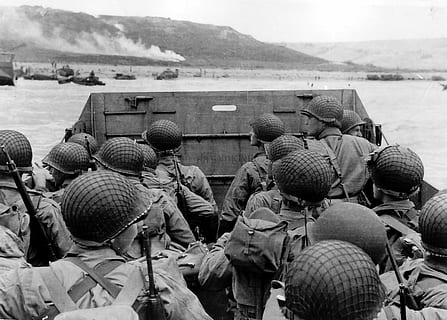
The Spanish-American War
Throughout the history of the United States, there have been many wars. Some of these, like the Civil War or World War II, are well known.


And yet, there are other, lesser-known wars that are of great importance to the history of the United States. One of these great historical moments was the Spanish-American War.
Time to don your uniform and march into history to learn more about the significance of a small time period in our history.
The times, they are a-changing
Our story begins with Christopher Columbus.

In 1492, he opened the door to the Americas for Europe. More specifically, he opened the door to the Americas for Spain. In short order, Spain established a vast empire, taking in most of the Americas and part of the Pacific Ocean.
Yet time would eat away at this great dominion:
Other European powers would explore and expand into North America, taking territory away. Later on, the United States would come and establish itself in North America.
Following the example of the American Revolution, different parts of the Americas revolted, breaking off and forming nations of their own.
At the close of the 1800s, this empire was reduced to a few territories:
The Caribbean islands of Puerto Rico and Cuba,
The Philippines and Guam in the Pacific
Some territory in Northwest Africa.
Also, at this time, the United States was beginning to come of age. It had become one of the largest industrial nations. Here were inventors like Edison and Bell. America looked forward with optimism to the new century.
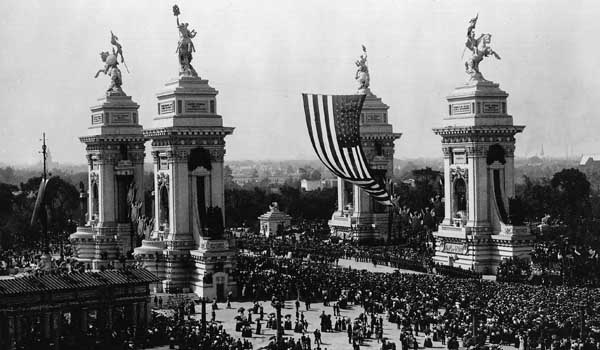
Photo of the Pan American Exposition, 1901.
Part of this new vision of itself in that modern world was an updated navy with modern ships. One of these was the battleship USS Maine.
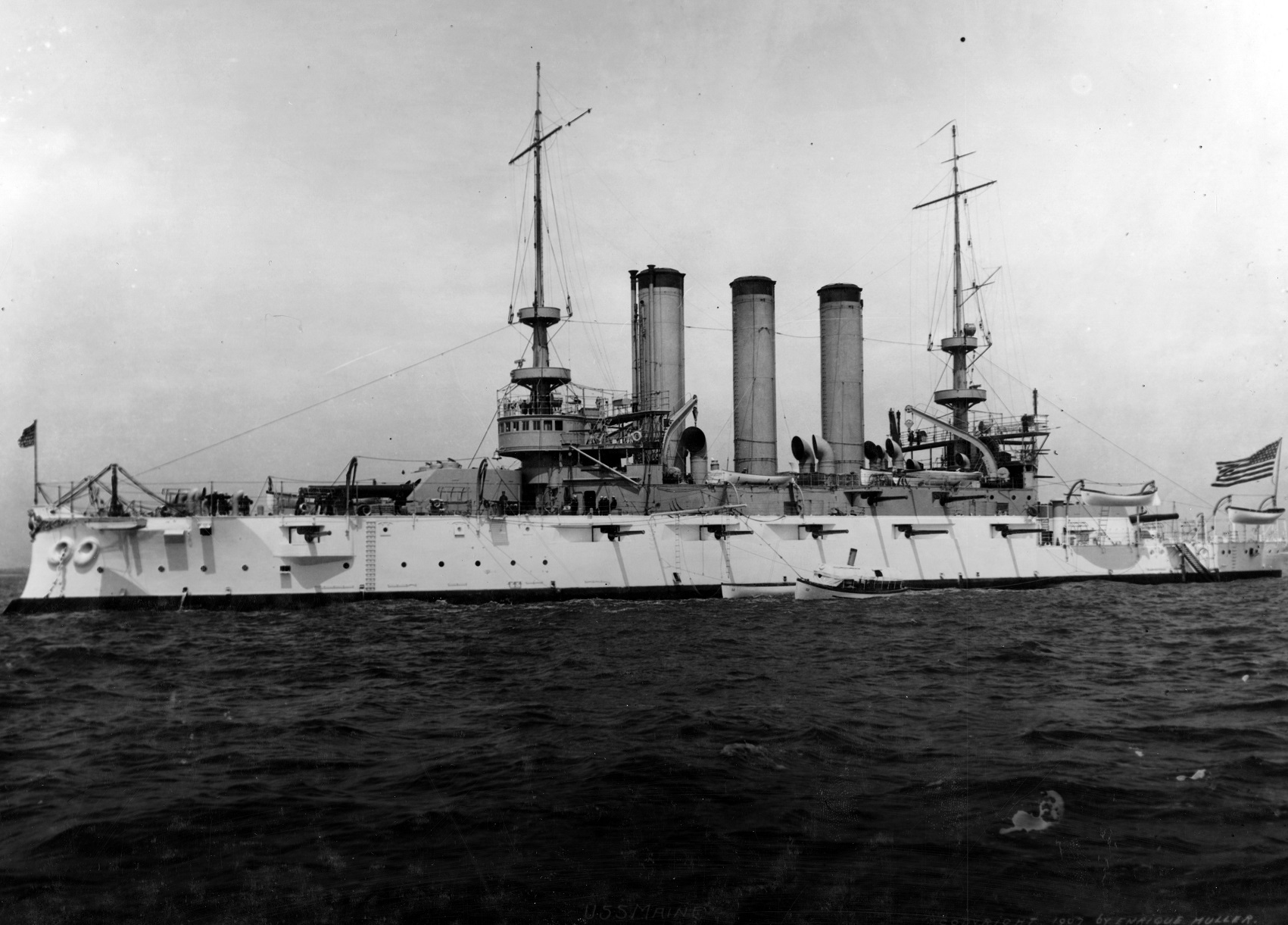
Trouble down south
So, let's go to Cuba.

Starting in 1868, Cubans started looking to be an independent country. Following the example of the United States, they rose up to fight to be free from Spain in a series of three revolts. During the last one, farms and other property were destroyed. The rebel leader, General Valeriano Weyler, ordered the population in his area to gather to select towns. The result was crowded, nasty conditions. It has been estimated that over 100,000 people ended up dying.
Naturally, Spain greatly opposed these revolts. Of course, there was the usual reason that no country wants to see a colony break away from it. But there was more. Spain saw Cuba as more than just a colony, but a part of Spain itself. It did not want Cuba to break away from its happy home.
During all this time, American businesses had invested millions in Cuban sugar plantations. So now, American businesses were keeping an eye on Cuba and their investments.
Besides, Americans like to see a colony break free – ever since 1776.
So as things went on, more and more Americans felt the United States should get involved.
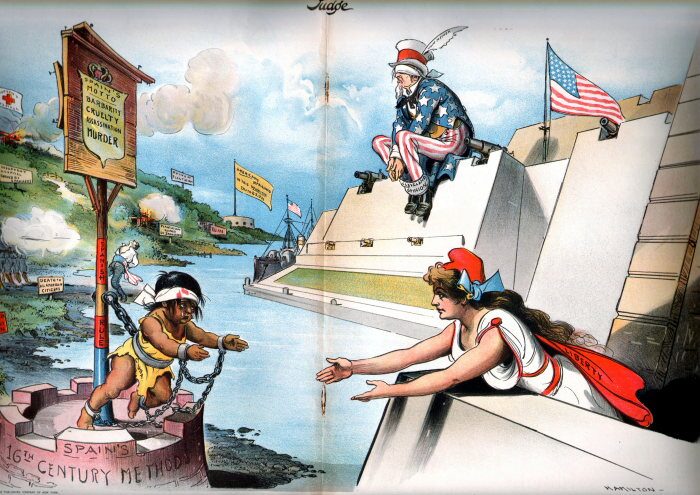
Editorial cartoon from Judge magazine, February 2, 1897. Here Columbia (the woman), representing the American people, seeks to help afflicted Cuba. Uncle Sam, representing the United States government, blindly ignores their plight.
Tensions between the United States and Spain were on the rise.
Rumors of war
In January 1898, President McKinley sent the battleship USS Maine to Havana Harbor in Cuba. The reason for its being dispatched was to provide an American presence and to protect U.S. citizens.
It would never return home.
On February 15th, an explosion violently erupted, blowing it up, sinking it, and killing 261 seamen. Immediately, American newspapers, eager to create a sensation, accused the Spanish of blowing it up themselves.
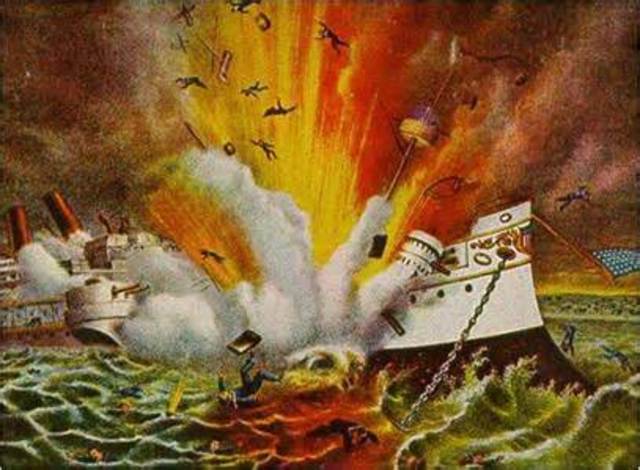
Dramatic depiction of the explosion of the USS Maine.
For their part, the Spanish denied the accusation and maintained it was a boiler explosion. (A study conducted much later would verify that this indeed was the case.) No matter. America was all worked up. President McKinley did not want to go to war, but the public pressure was growing. Finally, on April 11th, the President asked Congress for a declaration of war; it was not officially approved for another two weeks. Despite everything, the U.S. hesitated to get involved in this war.
So off the soldiers went, shouting the new battle cry, "Remember the Maine!"

Across the Pacific
The first action in the war by America was due to its navy. Here the Spanish fleet was no match for the modern vessels of the United States Navy. In the Pacific, the United States quickly gained victories in the Philippines and Guam, capturing both islands from Spain.
The capture of Guam was done without bloodshed. Upon arriving there, the U.S. ship fired shots at the fort without it firing back. It turned out that the Spanish commander didn't even know there was a war and thought the ship was firing a salute. He added to his embarrassment at being unable to respond as they were out of gunpowder.
The Spanish were taken as prisoners, and a single U.S. citizen, Francisco Martínez Portusach, was put in charge as governor. What were Francisco's qualifications for governor? He was the only United States citizen on the island.
The U.S. Navy had quickly taken control of the situation at sea. Now it was the army's turn.
Charge!
On June 10th, the American army landed in Cuba.
The Americans had a rough go of it for good reasons:
The Spanish Army was equipped with up-to-date weapons and employed modern battle tactics. Such was not the case for the American Army.
The tropical climate of Cuba and the dreaded yellow fever did not help, as all foreign soldiers (both Spanish and American) were particularly susceptible to the disease.
The food served to the soldiers wasn't the best quality. After the war, critics would claim more died from food poisoning than bullets.
The Americans got a lucky break when on July 3rd when the Spanish fleet left Cuba to try and break out of the American naval blockade.
A bad move on their part!
The Spanish fleet came across the more powerful United States Navy and was soundly defeated. Isolated, the Spanish surrendered Cuba two weeks later.

A couple of American units are worth mentioning.
Rough Riders
One was the 1st United States Volunteer Calvary, commonly called the "Rough Riders." In true democratic spirit, this unit contained members from all aspects of America, from rough western cowboys to rich elites of New York. One such example of the latter was Theodore Roosevelt, who had resigned as Assistant Secretary of the Navy to become a colonel in this outfit.
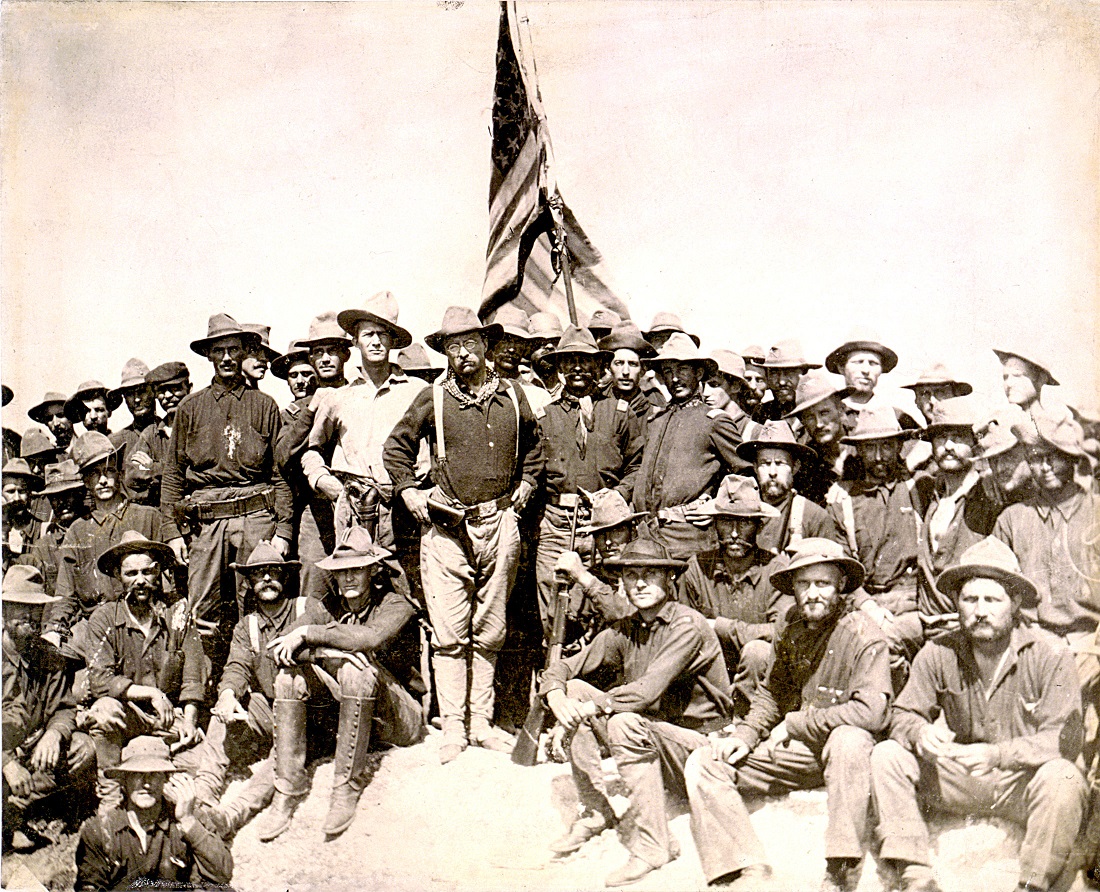
Photo of the Rough Riders with Teddy Roosevelt near the center.
The Rough Riders would gain fame in the battle of San Juan Hill. Initially, the unit was to hold the base of Kettle Hill to pull some Spanish forces away from the main force, but Roosevelt, not happy with just sitting there, managed to get his unit to charge up the hill and take it from the Spanish forces.

Army photo of the San Juan heights, the man pointing towards the top of Kettle Hill.
It was a somewhat reckless and, perhaps, an unwise move. But it made the unit, and its leader, legends.
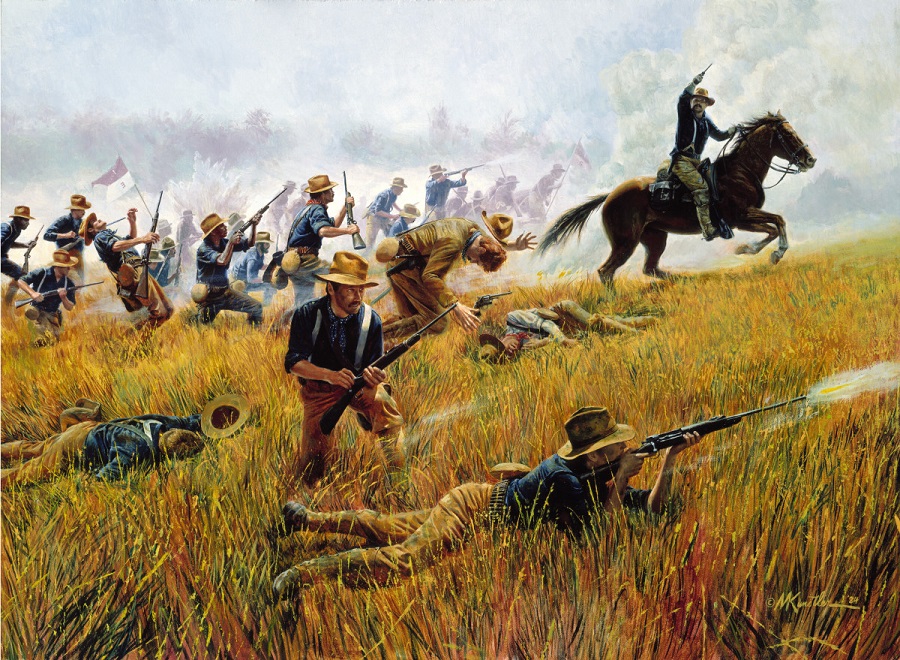
Buffalo soldiers
"Buffalo soldiers" are the name attached to American cavalry units made up of black soldiers. First established during the Civil War, these soldiers fought with distinction in the American West as well as the Spanish-American War, including taking part in the battle mentioned above.
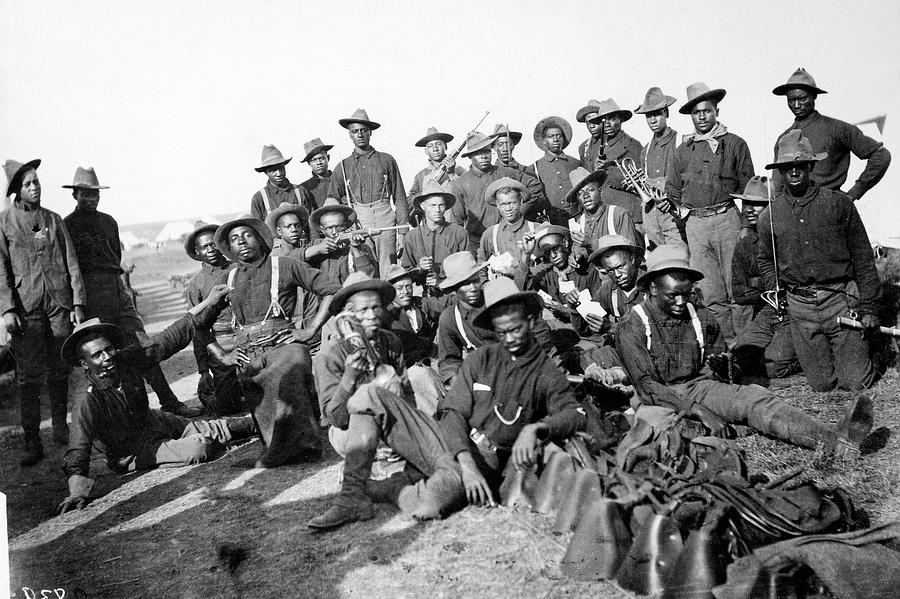
When the army left Cuba, elements of this unit would stay behind as temporary occupiers. The logic was that, since many were from southern states, they would be immune to the dreaded yellow fever. Sadly, it didn't work. They still got it.
Wrapping up
The last island involved in the war was the island of Puerto Rico. One thousand three hundred soldiers landed here in July of 1898, but had great difficulty with the defending Spanish. In the end, this tiny island would not be won on the battlefield but by treaty. On August 13th, 1898, the war ended with the Treaty of Paris. In the end, Spain lost the Philippines, Guam, and Puerto Rico to the United States.
But, the Cuban goal of freedom came to them as they gained their independence from Spain and would be looked after by the United States as a new country.
Stars are born
Because it lasted only five months, the Spanish-American War has been called a "splendid little war." Yet the consequences were huge. First, consider the international effects:
The last bit of the old Spanish Empire was all but gone.
Cuba is now its own country.
For the first time, the United States started to become a major player on the world stage and a major power in the Pacific.
The United States Navy showed its strength – after all, the Navy played a considerable role in the victory.
And then there's Teddy Roosevelt.
Ever the one to showcase his exploits, after the war published a book about his time in the war called The Rough Riders. In it, he boasted so much of his role in the war that, it was joked, the printer had to send out for more "I" type (blocks used to print a letter).

Roosevelt on his horse.
The self-promotion worked. Roosevelt was soon elected governor of New York, then Vice-President, and then (after President McKinley was shot in 1901) became the 26th President of the United States.
But perhaps the most valuable outcome was its effect on the United States itself. The Spanish-American War came 33 years after the end of the Civil War, which was a brutal war with lingering bitterness. When war broke out in 1898, people from both the North and South came together to fight a common enemy. In so doing, healing took place.
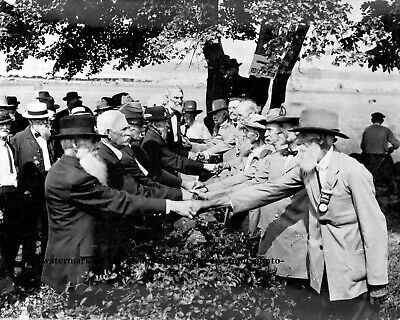
Former enemies shaking hands at the 50th anniversary of the battle of Gettysburg, 1913.
The saying has it to "set a thief to catch a thief." Sometimes, it seems, that it takes a war to heal from war.
God does move in mysterious ways sometimes.
Great films
The Wind and the Lion
(1975)
This classic film is based on a true story. The Perdicaris family is
an American family living in 1904 Morocco. The family is attacked,
the father is killed, and the mother and children are carried off.
How will President Theodore Roosevelt handle it? This is an excellent
movie, with about
the
best depiction of Teddy in a film I've seen.
(Warning: Rough language is used.)
On the web
The Spanish-American War in Motion Pictures
This website, maintained by the Library of Congress, contains a collection of silent film clips of scenes connected to the war.
Don't miss out on future posts! Sign up for our email list and like us on Facebook!
Check out more hot topics, go back to Home Page
Comments? You can contact me at mailbox@thehomegrownprofessor.com